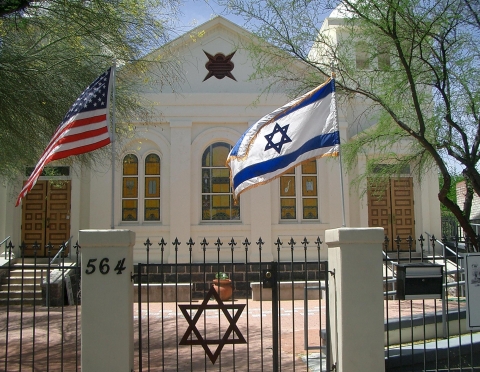The small building on South Stone Avenue in Tucson looks unimposing from the street. Set back from the curb by a small brick courtyard, its Arizona sand brick façade covered with 1930s whitewashed concrete, it could easily be missed altogether. However, its size belies the importance of this 2,500-square-foot structure. Built as the first synagogue building in the then Arizona Territory, the 1910 building holds the tales of the struggle to organize and sustain Arizona’s first Jewish congregation of 150 members, the Reform Temple Emanu-El.
Built for $4,712, the cornerstone was laid by the Tucson Masonic Lodge in June 1910, amid great pomp and circumstance. The small structure was filled a short 90 days later when, on the eve of Rosh Hashanah, Oct. 3, 1910, the first services were held. An invitation in the Tucson newspapers the day before had invited all area community members to join in the services, which had been promised to be “partially in English.”
Notes from the sisterhood tell of the hardships of World War I and how the small congregation held close to each other, the community and their faith. The notes of the early 1930s relate the anticipation of the arrival of the first rabbi; the formation of a new, more religious congregation holding services in the same building as the original temple; and of a looming World War II, including the loss of male members as they left for service and the return of the congregation’s wounded soldiers. The archives of photos tell of confirmations, new rabbis, B’nai B’rith meetings, the formation of the Jewish Federation, Jewish Social Services organizations and a growing Jewish community.
If they could, the walls of this historic structure would tell of the congregation’s struggle in making the decision to move out of the beloved building and into a newer, larger temple in the suburbs in 1949. The bricks would go on to share the joys of the 11 different churches that followed the Jewish congregations, including the evangelical Tucson Tabernacle. The congregation’s members today are counted across the world, and even make pilgrimages to the historic structure, to stand on the same bimah where their founder stood 50 years prior.
In the 1970s, the first Mexican radio station in Arizona, operated by the Mexican Consulate, broadcasted music and news from Tucson to Mexico from within the sanctuary walls.
The building also sheltered a tiny playhouse whose members often lived in the sanctuary because homosexuals were not welcome in apartment complexes, and there simply was nowhere else to find peace. But the structure’s rich history also includes some dark years, stained glass windows broken and boarded, walls decaying, in a neighborhood of poverty and crime, now sheltering the homeless, surviving the fires set to withstand the winter cold.
I like to think the walls shouted with joy as the condemned building was rescued from certain destruction in 1998 by the entire Tucson community, Jewish and non-Jewish members alike. A newly formed nonprofit promised, through financial hardships, to repair the structure and plans of renewal began to take shape. What came next was historic restoration, formation of a foundation to assure its future, a commitment to its preservation from the entire Southern Arizona region, and finally, the opening of one of Arizona’s premier museums, the Jewish History Museum.
Now individuals of all ages visit the restored structure to look at the photos and artifacts from long ago, and to appreciate the importance of the Jewish pioneers and the lessons their heritage teaches. Indeed, the building is small and unimposing, but its twin towers with rounded domes, located on what was a weed-filled plot on the edge of Tucson in 1910, speak to the lasting legacy of the entire Jewish community in Southern Arizona — and to its founders.
Those men and women came to a harsh unforgiving desert and carved out a Jewish community that now includes more than a dozen Jewish congregations of every denomination. These Jewish pioneers, who established for the first time the traditions of Judaism in Arizona: Reform, Conservative and Orthodox. They built Arizona’s first modern city, assured the start of Arizona’s first university, and helped to shape Arizona’s statehood.
If these sacred walls really could talk, they would tell the story of Jewish heritage that began with the dream of a permanent place to worship and continues with a legacy of Jewish pride.
Eileen Warshaw is the managing partner of Sacred Restoration, an international firm dedicated to saving houses of worship of all faiths.






